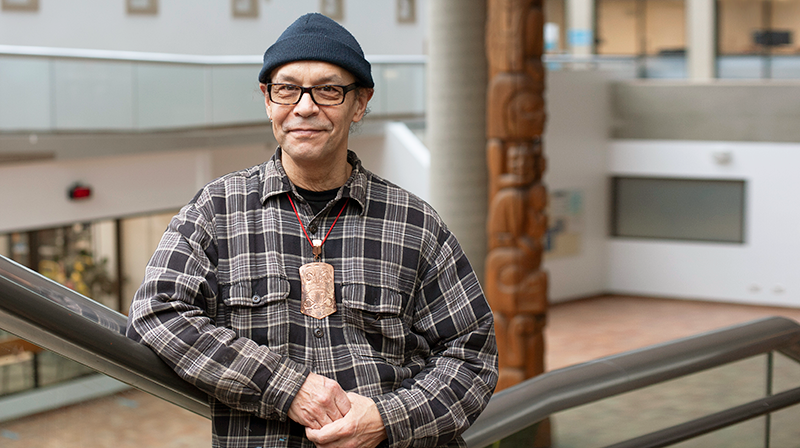Charles Ya’Ya Heit: Revealing the power of Indigenous art

Update: The VCC community was saddened to learn that Charles Ya'Ya Heit passed away in August of 2021, and it is our sincerest hope that his story and his art continue to inspire justice and reconciliation.
Even before Charles Heit was born in the Gitxsan community of Kispiox in northern British Columbia, his relatives began calling him “Ya’Ya,” a family nickname meaning “grandfather.”
“My grandmother’s uncle was the big chief, and I was first born after he died,” he explains. “We believe in reincarnation, so even as a small child, all these adults would call me Ya’Ya. They loved me like that too.”
In addition to his name, Ya’Ya also inherited his family’s artistic skill. Having learned traditional carving and drawing from a young age, Ya’Ya, who is now in his mid-60s, has contributed to some of the country’s most significant public Indigenous art pieces.
Now with grandchildren of his own, Ya’Ya continues to pursue new forms of art with the energy and curiosity of a high-school grad. For him, art not only runs through his veins, but also embodies his peoples’ history and identity, while being an important tool for resistance and justice.
Family foundations
Most recently, Ya’Ya’s art journey took him to Vancouver Community College (VCC) and the Jewellery Art and Design program, where he developed skills in stone setting, casting, and, his favourite, repouseé – a metalwork technique he describes as “hammering a piece of metal every which way” until it becomes a three-dimensional item such as a bracelet.
Long before he was setting gems and shaping metals, however, Ya’Ya was a wood carver, learning his craft from two rather famous uncles: Walter Harris (Chief Geel) and Earl Muldon (Chief Delgamuukw), both Gitxsan master carvers and recipients of the Order of Canada, whose legacies include totems, drawings, and other significant works in museums and public spaces across North America.

Ya'Ya' working in VCC's jewellery lab / Raven rattle pipe
“When we were kids, Uncle Walter would take us fishing. All I knew is he was a good fisherman and a carpenter,” says Ya’Ya. “I was 14 when I found out they were artists.”
At 15, with his parents’ support, Ya’Ya left what he calls his “white Canadian life” to stay with his grandparents, immerse himself in his Gitxsan culture, and train as a master carver at the Gitanmaax School of Northwest Coast Indian Art.
Throughout his carving career, Ya’Ya has worked with both his uncles as well as other greats such as award-wining Haida artist Robert Davidson. "When a friend would get a big commission, I would volunteer sometimes to help,” he says. “I love making big art so much.”
The art of resistance
“A lot of Gitxsan art made by my ancestors was to record history,” explains Ya’Ya. “So I’ve always been recording history.”
The significance of this history was recognized most notably in 1997 after Ya’Ya’s Gitxsan community won a decade-long lawsuit, one of the first recognizing Aboriginal title to traditional lands. Known today as the Delgamuukw Case, it was named after Ya’Ya’s uncle Earl Muldon, who worked tirelessly to establish oral history as valid evidence in court.
Ya’Ya himself has also supported his people’s ongoing struggle for land rights by learning and teaching geographic information systems (GIS) computer mapping, in addition to making powerful statements through his art.
“Being native in Canada is just a really bad experience,” says Ya’Ya. After the recent news about the residential school mass grave in Kamloops spread so widely, he hopes awareness of Indigenous issues will continue to increase. “I’m glad that some of Canada is opening their eyes to how horrific Canadian colonialism is.
Like many Indigenous people and their allies today, Ya’Ya has added this tragic news to a running list in his mind that includes the “wellness check” death of Chantel Moore in New Brunswick, the underfunding of Indigenous children in care, the destruction of thousand-year-old forests in Fairy Creek, B.C., and the 30-per cent unemployment rate in his home community.
“All this motivates me to say things with my art,” he says.

"Little Smiling Frog" repouseé silver bracelet (see more) / Self-portrait ring / Red garnet crown set ring
While he misses his village deeply, Ya’Ya says he’s experienced a lot of new things and quite enjoyed his time at VCC and in Vancouver. For now, he can be found hammering metal every which way at Rubble Rock and Gem in South Vancouver alongside numerous other VCC grads. “My classmates are one-third my age,” Ya’Ya says, continuing to live up to his name. “We’re a happy gang together.”
VCC is dedicated to creating a safe and empowering environment for First Nations, Inuit, and Métis learners through a range of supports and services. Learn more by visiting VCC Indigenous Education and Community Engagement.
